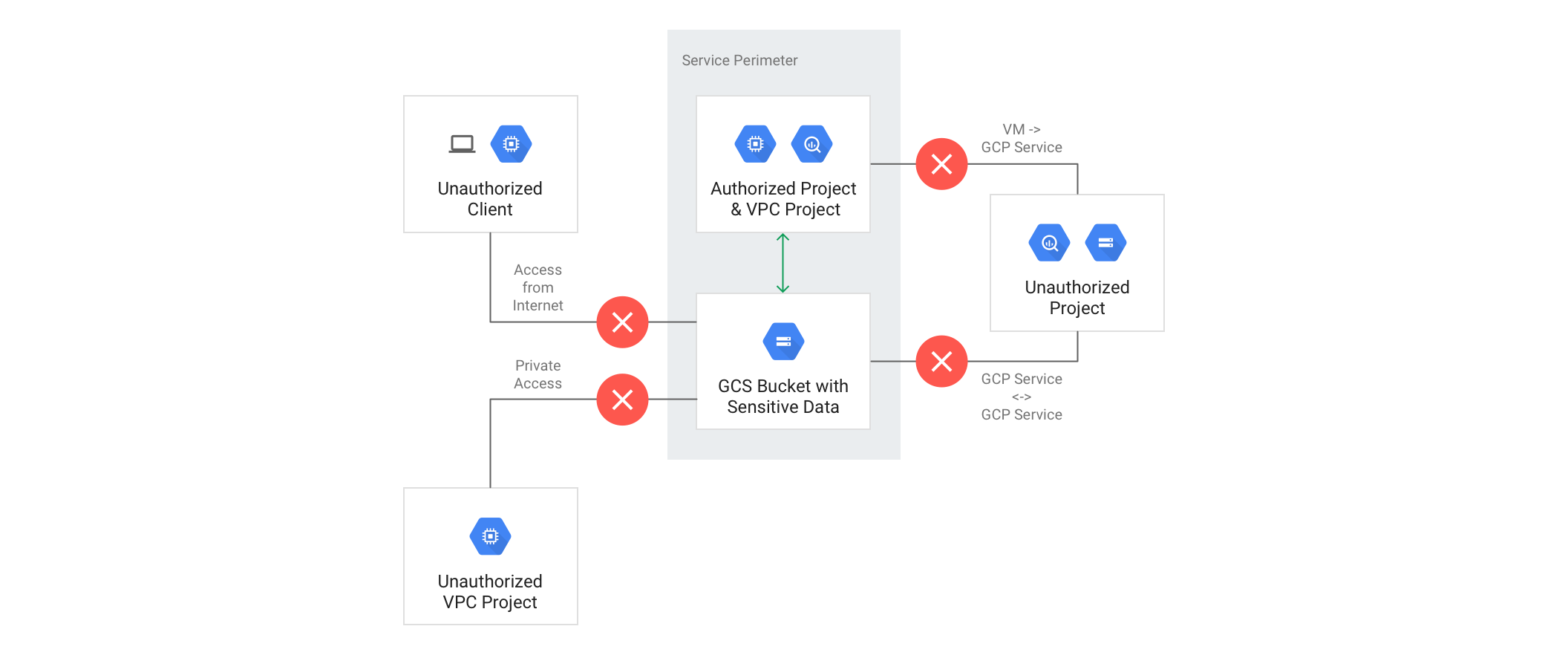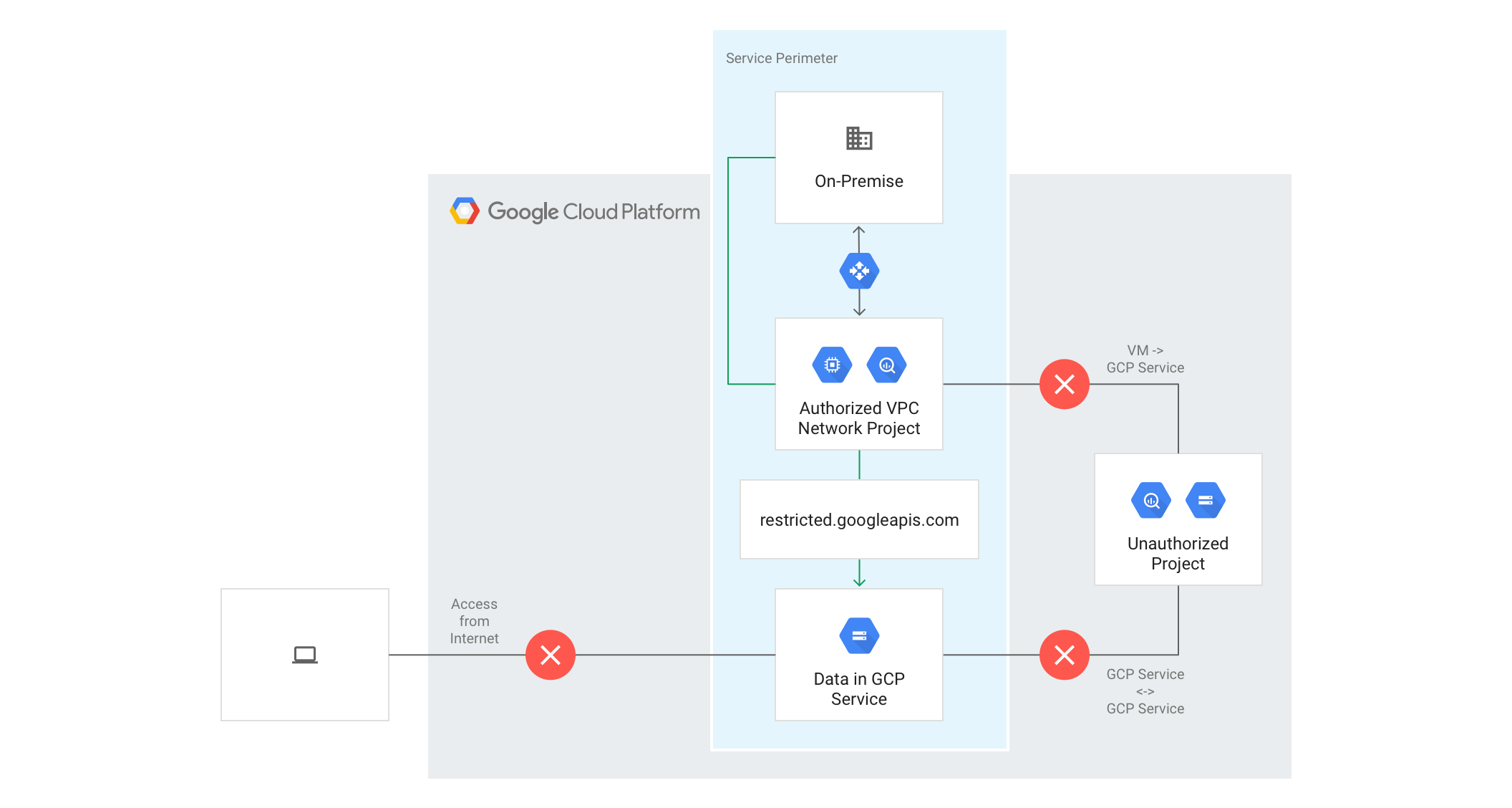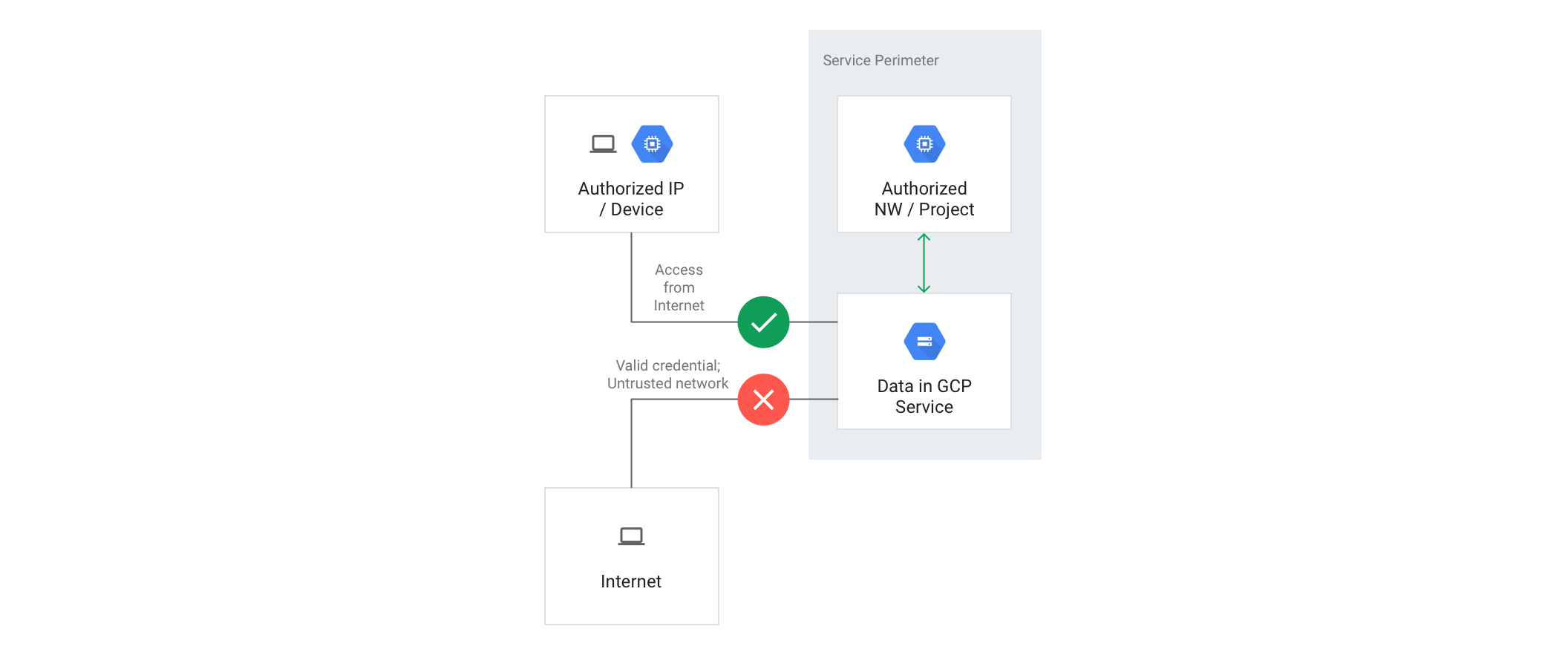This topic provides an overview of VPC Service Controls and describes its advantages and capabilities.
Who should use VPC Service Controls
Your organization might own intellectual property in the form of highly sensitive data, or your organization might handle sensitive data that is subject to additional data protection regulations, such as PCI DSS. Unintended loss or disclosure of sensitive data can lead to significant negative business implications.
If you are migrating from on-premises to the cloud, one of your goals might be to replicate your on-premises network based security architecture as you move your data to Google Cloud. To protect your highly sensitive data, you might want to ensure that your resources can only be accessed from trusted networks. Some organizations might allow public access to resources as long as the request originates from a trusted network, which can be identified based on the IP address of the request.
To mitigate data exfiltration risks, your organization might also want to ensure secure data exchange across organizational boundaries with fine-grained controls. As an administrator, you might want to ensure the following:
- Clients with privileged access don't also have access to partner resources.
- Clients with access to sensitive data can only read public data sets but not write to them.
How VPC Service Controls reduces data exfiltration risks
VPC Service Controls helps protect against accidental or targeted action by external entities or insider entities, which helps to minimize unwarranted data exfiltration risks from Google Cloud services such as Cloud Storage and BigQuery. You can use VPC Service Controls to create perimeters that protect the resources and data of services that you explicitly specify.
VPC Service Controls secures your Google Cloud services by defining the following controls:
Clients within a perimeter that have private access to resources do not have access to unauthorized (potentially public) resources outside the perimeter.
Data cannot be copied to unauthorized resources outside the perimeter using service operations such as
gcloud storage cporbq mk.Data exchange between clients and resources separated by perimeters is secured by using ingress and egress rules.
Context-aware access to resources is based on client attributes, such as identity type (service account or user), identity, device data, and network origin (IP address or VPC network). The following are examples of context-aware access:
Clients outside the perimeter that are on Google Cloud or on-premises are within authorized VPC resources and use Private Google Access to access resources within a perimeter.
Internet access to resources within a perimeter is restricted to a range of IPv4 and IPv6 addresses.
For more information, see Context-aware access using ingress rules.
VPC Service Controls provides an extra layer of security defense for Google Cloud services that is independent of Identity and Access Management (IAM). While IAM enables granular identity-based access control, VPC Service Controls enables broader context-based perimeter security, including controlling data egress across the perimeter. We recommend using both VPC Service Controls and IAM for defense in depth.
VPC Service Controls lets you monitor resource access patterns across your service perimeters using Cloud Audit Logs. For more information, see VPC Service Controls audit logging.
Security benefits of VPC Service Controls
VPC Service Controls helps mitigate the following security risks without sacrificing the performance advantages of direct private access to Google Cloud resources:
Access from unauthorized networks using stolen credentials: By allowing private access only from authorized VPC networks, VPC Service Controls helps protect against the risk of data exfiltration presented by clients using stolen OAuth or service account credentials.
Data exfiltration by malicious insiders or compromised code: VPC Service Controls complements network egress controls by preventing clients within those networks from accessing the resources of Google-managed services outside the perimeter.
VPC Service Controls also prevents reading data from or copying data to a resource outside the perimeter. VPC Service Controls prevents service operations such as a
gcloud storage cpcommand copying to a public Cloud Storage bucket or abq mkcommand copying to a permanent external BigQuery table.Google Cloud also provides a restricted virtual IP that is integrated with VPC Service Controls. The restricted VIP also allows requests to be made to services supported by VPC Service Controls without exposing those requests to the internet.
Public exposure of private data caused by misconfigured IAM policies: VPC Service Controls provides an extra layer of security by denying access from unauthorized networks, even if the data is exposed by misconfigured IAM policies.
Monitoring access to services: Use VPC Service Controls in dry run mode to monitor requests to protected services without preventing access and to understand traffic requests to your projects. You can also create honeypot perimeters to identify unexpected or malicious attempts to probe accessible services.
You can use an organization access policy and configure VPC Service Controls for your entire Google Cloud organization, or use scoped policies and configure VPC Service Controls for a folder or project in the organization. You retain the flexibility to process, transform, and copy data within the perimeter.
VPC Service Controls configurations are managed at the organization level by default, but scoped access policies for folders or projects can be used to delegate administration of service perimeters further down the resource hierarchy.
VPC Service Controls and metadata
VPC Service Controls is not designed to enforce comprehensive controls on metadata movement.
In this context, data is defined as content stored in a Google Cloud resource. For example, the contents of a Cloud Storage object. Metadata is defined as the attributes of the resource or its parent. For example, Cloud Storage bucket names.
The primary goal of VPC Service Controls is to control the movement of data, rather than metadata, across a service perimeter through supported services. VPC Service Controls also manages access to metadata, but there might be scenarios in which metadata can be copied and accessed without VPC Service Controls policy checks.
We recommend that you rely on IAM, including the use of custom roles, to ensure appropriate control over access to metadata.
Capabilities
VPC Service Controls lets you define security policies that prevent access to Google-managed services outside of a trusted perimeter, block access to data from untrusted locations, and mitigate data exfiltration risks.
You can use VPC Service Controls for the following use cases:
Isolate Google Cloud resources and VPC networks into service perimeters
Extend perimeters to on-premises networks using authorized VPN or Cloud Interconnect landing zone VPC networks.
Control access to Google Cloud resources from the internet
Protect data exchange across perimeters and organizations by using ingress and egress rules
Allow context-aware access to resources based on client attributes by using ingress rules
Isolate Google Cloud resources into service perimeters
A service perimeter creates a security boundary around Google Cloud resources. A service perimeter allows free communication within the perimeter but, by default, blocks communication to Google Cloud services across the perimeter.
The perimeter works specifically with Google Cloud managed services. The perimeter doesn't block access to any third-party APIs or services on the internet.
You can configure a perimeter to control the following types of communications:
- From public internet to customer resources within managed services
- From virtual machines (VMs) to a Google Cloud service (API)
- Between Google Cloud services
VPC Service Controls doesn't require you to have a Virtual Private Cloud (VPC) network. To use VPC Service Controls without having any resources on a VPC network, you can allow traffic from external IP ranges or certain IAM principals. For more information, see Create and manage access levels.
Here are some examples of VPC Service Controls creating a security boundary:
A VM within a VPC network that is part of a service perimeter can read from or write to a Cloud Storage bucket in the same perimeter. However, VPC Service Controls doesn't allow VMs within VPC networks that are outside the perimeter to access Cloud Storage buckets that are inside the perimeter. You must specify an ingress policy to allow VMs within VPC networks that are outside the perimeter to access Cloud Storage buckets that are inside the perimeter.
A host project that contains multiple VPC networks has a different perimeter policy for each VPC network in the host project.
A copy operation between two Cloud Storage buckets succeeds if both buckets are in the same service perimeter, but if one of the buckets is outside the perimeter, the copy operation fails.
VPC Service Controls doesn't allow a VM within a VPC network that is inside a service perimeter to access Cloud Storage buckets that are outside the perimeter.
The following diagram shows a service perimeter that allows communication between a VPC project and Cloud Storage bucket inside the perimeter but blocks all communication across the perimeter:
Extend perimeters to an authorized VPN or Cloud Interconnect
You can configure private communication to Google Cloud resources from VPC networks that span hybrid environments with Private Google Access on-premises extensions. To privately access Google Cloud resources within a perimeter, the VPC network that contains the landing zone from on-premises must be a part of the perimeter for resources in the on-premises network.
VMs with private IP addresses in a VPC network secured by a service perimeter cannot access managed resources outside the service perimeter. If necessary, you can continue to enable inspected and audited access to all Google APIs (for example, Gmail) over the internet.
The following diagram shows a service perimeter that extends to hybrid environments with Private Google Access:
Control access to Google Cloud resources from the internet
Access from the internet to managed resources within a service perimeter is denied by default. Optionally, you can enable access based on the context of the request. To do so, you can create ingress rules or access levels to permit access based on various attributes, such as the source IP address, identity, or source Google Cloud project. If requests made from the internet don't meet the criteria defined in the ingress rule or access level, the requests are denied.
To use the Google Cloud console to access resources within a perimeter, you must configure an access level that allows access from one or more IPv4 and IPv6 ranges, or to specific user accounts.
The following diagram shows a service perimeter that allows access from the internet to protected resources based on the configured access levels, such as IP address or device policy:
Other controls to mitigate data exfiltration risks
- Domain restricted sharing: You can consider setting up an organizational policy to limit resource sharing to identities that belong to a particular organization resource. For more information, see Restricting identities by domain.
- Uniform bucket-level access: To uniformly control access to your Cloud Storage buckets, consider setting up bucket-level IAM permissions. Using uniform bucket-level access lets you use other Google Cloud security features such as domain restricted sharing, Workforce Identity Federation, and IAM conditions.
- Multi-factor authentication: We recommend using multi-factor authentication to access your Google Cloud resources.
- Post-deployment scans: You can consider using the following
post-deployment scanning tools to scan for open Cloud Storage buckets:
- Security Command Center
- Cloud Asset Inventory to search asset metadata history and analyse IAM policy to understand who has access to what.
- Third-party tools like Palo Alto PrismaCloud
- De-identification of sensitive data: You can consider using Sensitive Data Protection to discover, classify, and de-identify sensitive data inside and outside Google Cloud. De-identification of sensitive data can be done by redaction, tokenization, or encryption.
- Automation using infrastructure-as-code tools: We recommend that you deploy Cloud Storage buckets using an automation tool to control access to the buckets. Pass the infrastructure-as-code through human or automated reviews before deployment.
Unsupported Services
For more information on products and services that are supported by VPC Service Controls, refer to the Supported products page.
Attempting to restrict an unsupported service using the gcloud command-line tool or
the Access Context Manager API will result in an error.
Cross-project access to data of supported services will be blocked by VPC Service Controls. Additionally, the restricted VIP can be used to block the ability of workloads to call unsupported services.
Known limitations
There are some known limitations with certain Google Cloud services, products, and interfaces when you use VPC Service Controls. For example, VPC Service Controls doesn't support all Google Cloud services. Therefore, don't enable unsupported Google Cloud services in the perimeter. For more information, see the VPC Service Controls supported products list. If you need to use a service that VPC Service Controls doesn't support, enable the service in a project that is outside the perimeter.
We recommend that you review known limitations before you include Google Cloud services in the perimeter. For more information, see the VPC Service Controls service limitations.
Glossary
In this topic, you have learned about several new concepts introduced by VPC Service Controls:
- VPC Service Controls
- Technology that enables you to define a service perimeter around resources of Google-managed services to control communication to and between those services.
- service perimeter
- A service perimeter around Google-managed resources. Allows free communication within the perimeter but, by default, blocks all communication across the perimeter.
- ingress rule
- A rule that allows an API client that is outside the perimeter to access resources within a perimeter. For more information, see Ingress and egress rules.
- egress rule
- A rule that allows an API client or resource that is inside the perimeter to access Google Cloud resources outside the perimeter. The perimeter does not block access to any third-party API or services on the internet.
- service perimeter bridge
A perimeter bridge allows projects in different service perimeters to communicate. Perimeter bridges are bidirectional, allowing projects from each service perimeter equal access within the scope of the bridge.
- Access Context Manager
A context-aware request classification service that can map a request to an access level based on specified attributes of the client, such as the source IP address. For more information, see Overview of Access Context Manager.
- access level
A classification of requests over the internet based on several attributes, such as source IP range, client device, geolocation, and others. Just like an ingress rule, you can use an access level to configure a service perimeter to grant access from the internet based on the access level associated with a request. You can create an access level using Access Context Manager.
- access policy
A Google Cloud resource object that defines service perimeters. You can create access policies that are scoped to specific folders or projects alongside an access policy that can apply to the entire organization. An organization can have only one organization-level access policy.
- scoped policy
A scoped policy is an access policy that is scoped to specific folders or projects alongside an access policy that applies to the entire organization. For more information, see Overview of scoped policies.
- restricted VIP
The restricted VIP provides a private network route for products and APIs supported by VPC Service Controls in order to make data and resources used by those products inaccessible from the internet.
restricted.googleapis.comresolves to199.36.153.4/30. This IP address range is not announced to the internet.
What's next
- Learn about service perimeter configuration.
- Understand how to manage VPC networks in service perimeters
- Review the known service limitations.



